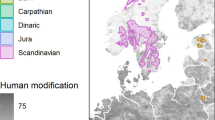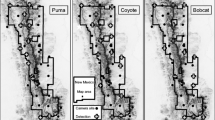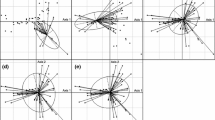Abstract
Differentiation in habitat selection among sympatric species may depend on niche partitioning, species interactions, selection mechanisms and scales considered. In a mountainous area in Sweden, we explored hierarchical habitat selection in Global Positioning System-collared individuals of two sympatric large carnivore species; an obligate predator, the Eurasian lynx (Lynx lynx), and a generalist predator and scavenger, the wolverine (Gulo gulo). Although the species’ fundamental niches differ widely, their ranges overlap in this area where they share a prey base and main cause of mortality. Both lynx and wolverines selected for steep and rugged terrain in mountainous birch forest and in heaths independent of scale and available habitats. However, the selection of lynx for their preferred habitats was stronger when they were forming home ranges and they selected the same habitats within their home ranges independent of home range composition. Wolverines displayed a greater variability when selecting home ranges and habitat selection also varied with home range composition. Both species selected for habitats that promote survival through limited encounters with humans, but which also are rich in prey, and selection for these habitats was accordingly stronger in winter when human activity was high and prey density was low. We suggest that the observed differences between the species result primarily from different foraging strategies, but may also depend on differences in ranging and resting behaviour, home range size, and relative density of each species. Our results support the prediction that sympatric carnivores with otherwise diverging niches can select for the same resources when sharing main sources of food and mortality.





Similar content being viewed by others
References
Anderson DP, Turner MG, Forrester JD, Zhu J, Boyce MS, Beyer H, Stowell L (2005) Scale-dependent summer resource selection by reintroduced elk in Wisconsin, USA. J Wildl Manage 69:298–310
Andrén H, Linnell JDC, Liberg O, Andersen R, Danell A, Karlsson J, Odden J, Moa PF, Ahlqvist P, Kvam T, Franzén R, Segerström P (2006) Survival rates and causes of mortality in Eurasian lynx (Lynx lynx) in multi-use landscapes. Biol Conserv 131:23–32
Andrén H, Persson J, Mattisson J, Danell AC (2011) Modelling the combined effect of an obligate predator and a facultative predator on a common prey—lynx and wolverine predation on reindeer. Wildl Biol 17:33–43
Arnemo JM, Evans A, Fahlman Å (2011) Biomedical protocols for free-ranging brown bears, gray wolves, wolverines and lynx. http://www.rovviltportalen.no/content.ap?thisId=500039688. Accessed 29 Jan 2011
Basille M, Herfindal I, Santin-Janin H, Linnell JDC, Odden J, Andersen R, Hogda KA, Gaillard JM (2009) What shapes Eurasian lynx distribution in human dominated landscapes: selecting prey or avoiding people? Ecography 32:683–691
Belant JL, Griffith B, Zhang Y, Follmann EH, Adams LG (2010) Population-level resource selection by sympatric brown and American black bears in Alaska. Polar Biol 33:31–40
Beyer HL, Haydon DT, Morales JM, Frair JL, Hebblewhite M, Mitchell M, Matthiopoulos J (2010) The interpretation of habitat preference metrics under use-availability designs. Philos Trans R Soc Lond B 365:2245–2254
Boles BK (1977) Predation by wolves on wolverine. Can Field Nat 91:68–69
Boulinier T, Mariette M, Doligez B, Danchin É (2008) Choosing where to breed: breeding habitat choice. In: Danchin É, Giraldeau L-A, Cézilly F (eds) Behavioural ecology. Oxford University Press, New York, pp 285–321
Boyce MS, Vernier PR, Nielsen SE, Schmiegelow FKA (2002) Evaluating resource selection functions. Ecol Model 157:281–300
Breitenmoser U, Breitenmoser-Würsten C, Capt S, Molinari-Jobin A, Molinari P, Zimmermann F (2007) Conservation of the lynx Lynx lynx in the Swiss Jura Mountains. Wildl Biol 13:340–355
Breitenmoser-Würsten C, Zimmerman F, Stahl P, Vandel JM, Molinari-Jobin A, Molinari P, Capt S, Breitenmoser U (2007) Spatial and social stability of a Eurasian lynx Lynx lynx population: an assessment of 10 years of observation in the Jura Mountains. Wildl Biol 13:365–380
Brøseth H, Flagstad Ø, Wardig C, Johansson M, Ellegren H (2010) Large-scale noninvasive genetic monitoring of wolverines using scats reveals density dependent adult survival. Biol Conserv 143:113–120
Calenge C (2006) The package “adehabitat” for the R software: a tool for the analysis of space and habitat use by animals. Ecol Model 197:516–519
Calenge C, Dufour AB, Maillard D (2005) K-select analysis: a new method to analyse habitat selection in radio-tracking studies. Ecol Model 186:143–153
Copeland JP, Peek JM, Groves CR, Melquist NE, McKelvey KS, McDaniel GW, Long DC, Harris CE (2007) Seasonal habitat associations of the wolverine in central Idaho. J Wildl Manage 71:2201–2212
Danell AC, Andrén H, Segerström P, Franzen R (2006) Space use by Eurasian lynx in relation to reindeer migration. Can J Zool 84:546–555
Gaillard JM, Hebblewhite M, Loison A, Fuller M, Powell R, Basille M, Van Moorter B (2010) Habitat-performance relationships: finding the right metric at a given spatial scale. Philos Trans R Soc Lond B 365:2255–2265
Giraldeau L-A (2008) Solitary foraging strategies. In: Danchin É, Giraldeau L-A, Cézilly F (eds) Behavioural ecology. Oxford University Press, New York, pp 233–255
Haglund B (1966) De stora rovdjurens vintervanor Ι. (Winter habits of the lynx (Lynx lynx L.) and wolverine (Gulo gulo L.) as revealed by tracking in the snow). Viltrevy 4:81–310
Hall LS, Krausman PR, Morrison ML (1997) The habitat concept and a plea for standard terminology. Wildl Soc Bull 25:173–182
Hebblewhite M, Merrill EH (2009) Trade-offs between predation risk and forage differ between migrant strategies in a migratory ungulate. Ecology 90:3445–3454
Hirzel AH, Hausser J, Chessel D, Perrin N (2002) Ecological-niche factor analysis: how to compute habitat-suitability maps without absence data? Ecology 83:2027–2036
Hutchinson GE (1957) Population studies—animal ecology and demography—concluding remarks. Cold Spring Harb Symp Quant Biol 22:415–427
Johnson DH (1980) The comparison of usage and availability measurements for evaluating resource preference. Ecology 61:65–71
Kittle AM, Fryxell JM, Desy GE, Hamr J (2008) The scale-dependent impact of wolf predation risk on resource selection by three sympatric ungulates. Oecologia 157:163–175
Linnell JDC, Strand O (2000) Interference interactions, co-existence and conservation of mammalian carnivores. Divers Distrib 6:169–176
Mattisson J, Andrén H, Persson J, Segerström P (2010) Effects of species behavior on global positioning system collar fix rates. J Wildl Manage 74:557–563
Mattisson J, Andrén H, Persson J, Segerström P (2011a) Influence of intraguild interactions on resource use by wolverines and Eurasian lynx. J Mammal 92:1321–1330
Mattisson J, Odden J, Nilsen EB, Linnell JDC, Persson J, Andrén H (2011b) Factors affecting Eurasian lynx kill rates on semi-domestic reindeer in northern Scandinavia: can ecological research contribute to the development of a fair compensation system? Biol Conserv 144:3009–3017
Mattisson J, Persson J, Andrén H, Segerström P (2011c) Temporal and spatial interactions between an obligate predator, the Eurasian lynx (Lynx lynx), and a facultative scavenger, the wolverine (Gulo gulo). Can J Zool 89:79–89
May R, Landa A, van Dijk J, Linnell JDC, Andersen R (2006) Impact of infrastructure on habitat selection of wolverines Gulo gulo. Wildl Biol 12:285–295
May R, van Dijk J, Wabakken P, Swenson J, Linnell JDC, Zimmerman B, Odden J, Pedersen HC, Andersen R, Landa A (2008) Habitat differentiation within the large-carnivore community of Norway’s multiple-use landscapes. J Appl Ecol 45:1382–1391
May R, van Dijk J, Landa A, Andersen R (2010) Spatio-temporal ranging behaviour and its relevance to foraging strategies in wide-ranging wolverines. Ecol Model 221:936–943
McLoughlin PD, Morris DW, Fortin D, Vander Wal E, Contasti AL (2010) Considering ecological dynamics in resource selection functions. J Anim Ecol 79:4–12
Mysterud A, Ims RA (1998) Functional responses in habitat use: availability influences relative use in trade-off situations. Ecology 79:1435–1441
Odden J, Linnell JDC, Andersen R (2006) Diet of Eurasian lynx, Lynx lynx, in the boreal forest of southeastern Norway: the relative importance of livestock and hares at low roe deer density. Eur J Wildl Res 52:237–244
Pedersen VA, Linnell JDC, Andersen R, Andrén H, Linden M, Segerström P (1999) Winter lynx Lynx lynx predation on semi-domestic reindeer Rangifer tarandus in northern Sweden. Wildl Biol 5:203–211
Persson J, Ericsson G, Segerström P (2009) Human caused mortality in the endangered Scandinavian wolverine population. Biol Conserv 142:325–331
Persson J, Wedholm P, Segerström P (2010) Space use and territoriality of wolverines (Gulo gulo) in northern Scandinavia. Eur J Wildl Res 56:49–57
R Development Core Team (2009) R: a language and environment for statistical computing. R Foundation for Statistical Computing, Vienna
Rettie WJ, Messier F (2000) Hierarchical habitat selection by woodland caribou: its relationship to limiting factors. Ecography 23:466–478
Rodgers AR, Carr AP, Beyer HL, Smith L, Kie JG (2007) HRT: home range tools for ArcGIS. In: Ontario Ministry of Natural Resources, Centre for Northern Forest Ecosystem Research, Thunder Bay, Ontario, Canada
Sokal RR, Rohlf FJ (1981) Biometry.The principles and practice of statistics in biological research, 2nd edn. Freeman, San Francisco
Sæther BE, Engen S, Persson J, Brøseth H, Landa A, Willebrand T (2005) Management strategies for the wolverine in Scandinavia. J Wildl Manage 69:1001–1014
Sæther BE, Engen S, Odden J, Linnell JDC, Grotan V, Andrén H (2010) Sustainable harvest strategies for age-structured Eurasian lynx populations: the use of reproductive value. Biol Conserv 143:1970–1979
Samelius G, Alisauskas RT, Lariviere S, Bergman C, Hendricson CJ, Phipps K, Wood C (2002) Foraging behaviours of wolverines at a large arctic goose colony. Arctic 55:148–150
Samelius G, Andrén H, Liberg O, Linnell JDC, Odden J, Ahlqvist P, Segerström P, Sköld K (2012) Spatial and temporal variation in natal dispersal by Eurasian lynx in Scandinavia. J Zool 286:120–130
Sappington JM, Longshore KM, Thompson DB (2007) Quantifying landscape ruggedness for animal habitat analysis: a case study using bighorn sheep in the Mojave Desert. J Wildl Manage 71:1419–1426
Skarin A, Danell O, Bergström R, Moen J (2008) Summer habitat preferences of GPS-collared reindeer Rangifer tarandus tarandus. Wildl Biol 14:1–15
van Dijk J, Gustavsen L, Mysterud A, May R, Flagstad Ø, Brøseth H, Andersen R, Andersen R, Steen H, Landa A (2008) Diet shift of a facultative scavenger, the wolverine, following recolonization of wolves. J Anim Ecol 77:1183–1190
Vangen KM, Persson J, Landa A, Andersen R, Segerström P (2001) Characteristics of dispersal in wolverines. Can J Zool 79:1641–1649
Acknowledgments
The study was funded by the Swedish Environmental Protection Agency, the Norwegian Directorate for Nature Management, the Swedish Research Council for Environment, Agricultural Sciences and Spatial Planning (Formas), the World Wide Fund for Nature (Sweden), and the private foundations Olle och Signhild Engkvists Stiftelser and Marie-Claire Cronstedts Stiftelse. We thank Peter Segerström and Tom Wiklund for field assistance and Jon Arnemo for veterinary assistance. We thank Gustaf Samelius, Johan Månsson, Tomas Willebrand, and an anonymous reviewer for valuable comments on earlier drafts.
Author information
Authors and Affiliations
Corresponding author
Additional information
Communicated by Ilpo Kojola.
Rights and permissions
About this article
Cite this article
Rauset, G.R., Mattisson, J., Andrén, H. et al. When species’ ranges meet: assessing differences in habitat selection between sympatric large carnivores. Oecologia 172, 701–711 (2013). https://doi.org/10.1007/s00442-012-2546-y
Received:
Accepted:
Published:
Issue Date:
DOI: https://doi.org/10.1007/s00442-012-2546-y




